人教版(2019)选择性必修第二册Unit5First Aid Reading and thinking First Aid For Burns课件-(25张ppt,内镶嵌视频素材)
文档属性
| 名称 | 人教版(2019)选择性必修第二册Unit5First Aid Reading and thinking First Aid For Burns课件-(25张ppt,内镶嵌视频素材) | 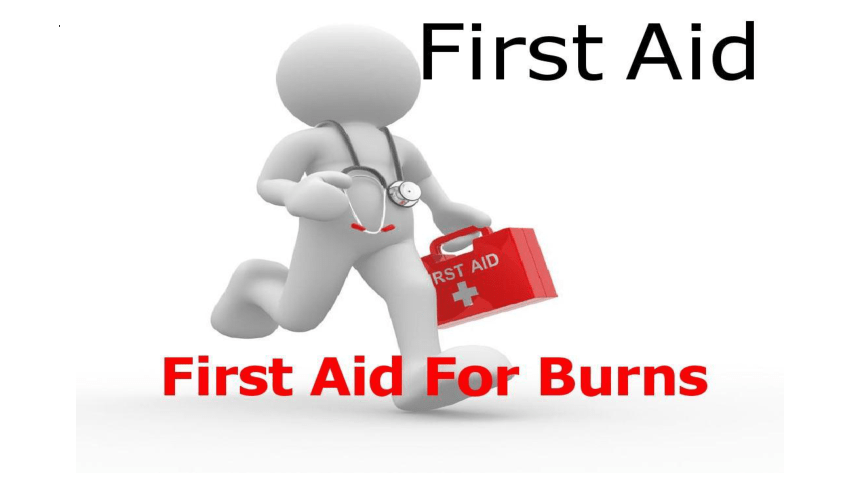 | |
| 格式 | pptx | ||
| 文件大小 | 29.5MB | ||
| 资源类型 | 教案 | ||
| 版本资源 | 人教版(2019) | ||
| 科目 | 英语 | ||
| 更新时间 | 2023-01-28 19:17:05 | ||
图片预览

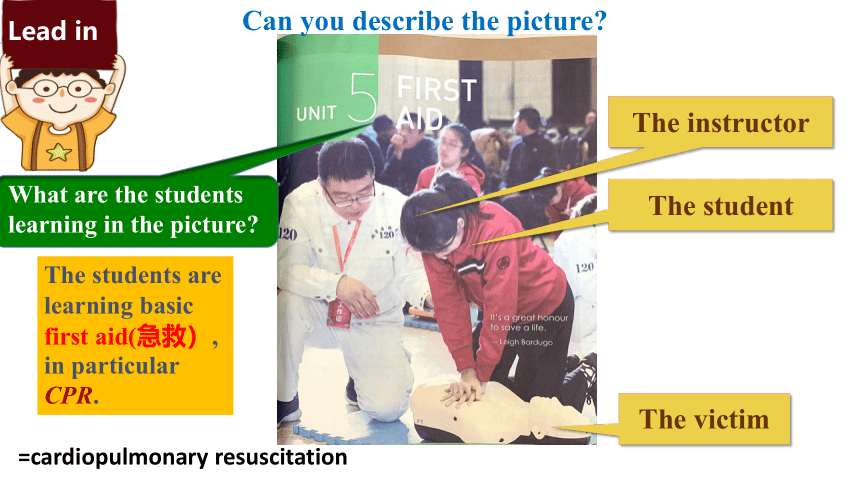
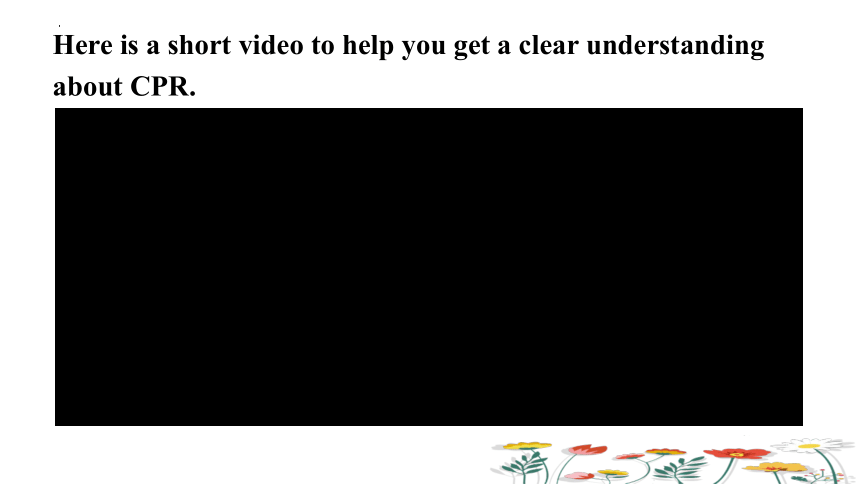
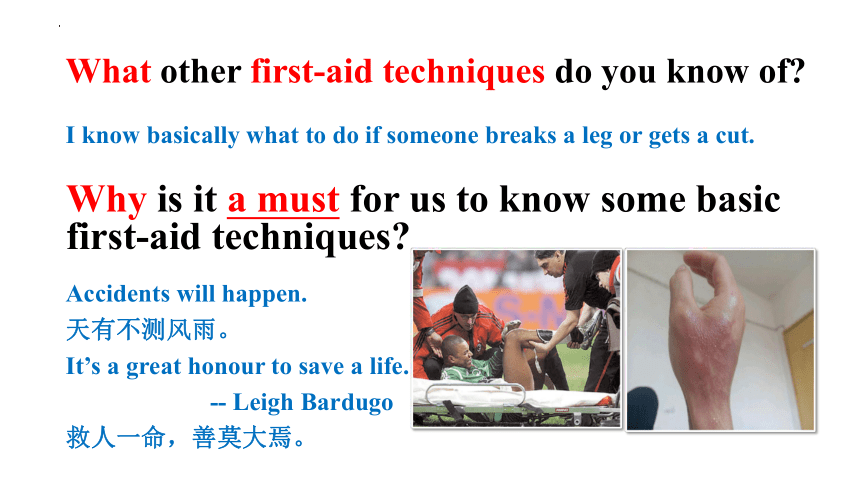
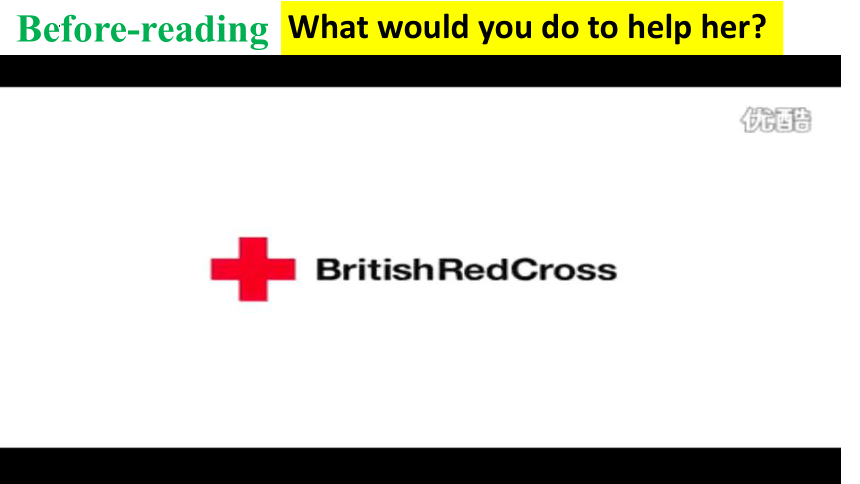
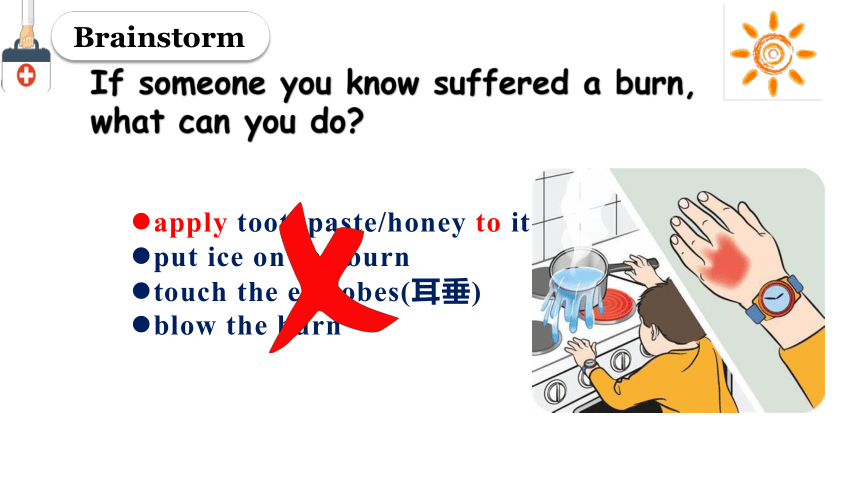
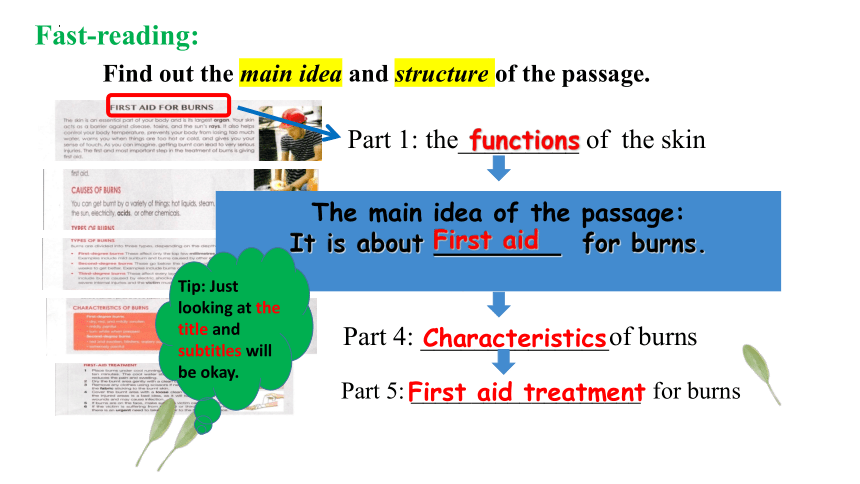
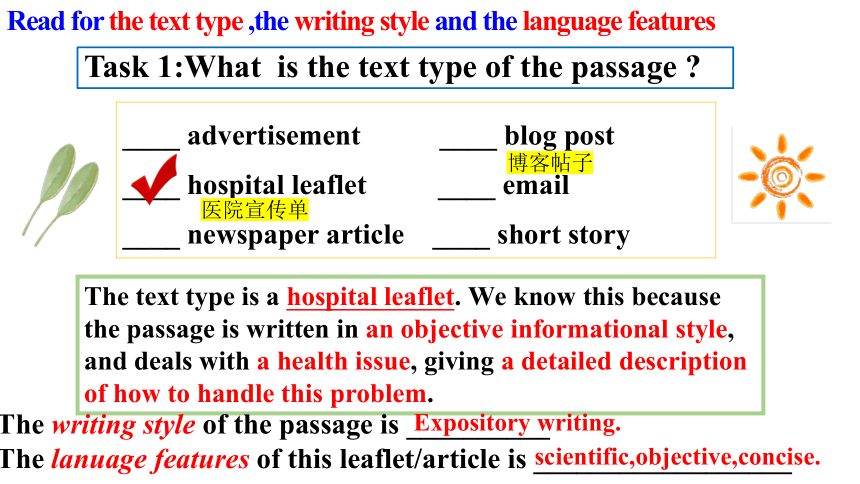
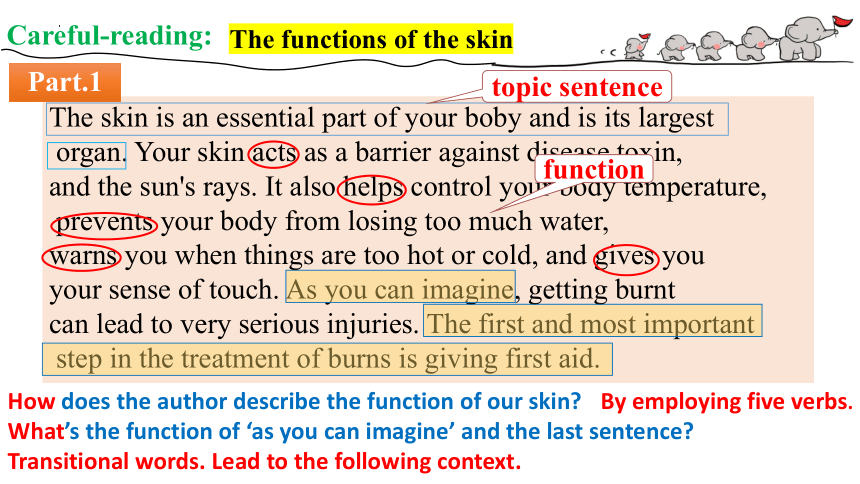
文档简介
(共25张PPT)
First Aid for Burns
Lead in
Can you describe the picture
The instructor
The victim
What are the students learning in the picture
The students are learning basic first aid(急救), in particular CPR.
The student
=cardiopulmonary resuscitation
Here is a short video to help you get a clear understanding about CPR.
What other first-aid techniques do you know of
I know basically what to do if someone breaks a leg or gets a cut.
Why is it a must for us to know some basic first-aid techniques
Accidents will happen.
天有不测风雨。
It’s a great honour to save a life.
-- Leigh Bardugo
救人一命,善莫大焉。
What would you do to help her
Before-reading
apply toothpaste/honey to it
put ice on the burn
touch the earlobes(耳垂)
blow the burn
If someone you know suffered a burn, what can you do
Brainstorm
Find out the main idea and structure of the passage.
Part 1: the_________ of the skin
Part 2: _________of burns
Part 3: _________of burns
Part 4: ______________of burns
Part 5: ___________________ for burns
Causes
Types
First aid treatment
Characteristics
The main idea of the passage:
It is about ________ for burns.
First aid
Fast-reading:
Tip: Just looking at the title and subtitles will be okay.
functions
____ advertisement ____ blog post
____ hospital leaflet ____ email
____ newspaper article ____ short story
Task 1:What is the text type of the passage
Read for the text type ,the writing style and the language features
医院宣传单
博客帖子
The text type is a hospital leaflet. We know this because the passage is written in an objective informational style, and deals with a health issue, giving a detailed description of how to handle this problem.
The writing style of the passage is __________
The lanuage features of this leaflet/article is __________________
scientific,objective,concise.
Expository writing.
The skin is an essential part of your boby and is its largest
organ. Your skin acts as a barrier against disease,toxin,
and the sun's rays. It also helps control your body temperature,
prevents your body from losing too much water,
warns you when things are too hot or cold, and gives you
your sense of touch. As you can imagine, getting burnt
can lead to very serious injuries. The first and most important
step in the treatment of burns is giving first aid.
function
topic sentence
Part.1
Careful-reading:
The functions of the skin
How does the author describe the function of our skin
What’s the function of ‘as you can imagine’ and the last sentence
Transitional words. Lead to the following context.
By employing five verbs.
Complete the following sentences.
functions of the skin
Acts as a barrier against disease, toxins, and the sun’s ______;
prevents your body from _____________
________________
warns you when things are too _____ or _____
gives you ______________
body temperature
losing too much water
cold
hot
sense of touch
to control your ____________
rays
1
2
3
4
5
Part.2 Causes of burns
You can get burnt by a variety of things: hot liquids, steam, fire, radiation, the sun, electricity, acids, or other chemicals.
What may cause you to get burned
hot liquids
steam
fire
the sun
electricity
acids
radiation
chemicals
What’s author’s purpose by mentioning this part
1.To inform us of the causes of burns.
2.To stress how easily we can get burned.
3.To remind us to be really careful to avoid getting burned.
The third layer
The second layer
The top layer
First-degree burns
Second-degree burns
Third-degree burns
How many types of burns are there?What are they
In each type, which layer of the skin is affected (find the topic sentence)
Part 3: Types of burns
Burns are divided into three types, depending on the depth of skin damage.
A: First-degree burns These affect only the top few millimetres of the skin. These burns are not serious. Examples include mild sunburn and burns caused by other minor household incidents.
B: Second-degree burns These go below the top layer of the skin.They are serious and take a few weeks to get better. Examples include burns caused by hot liquids.
C: Third-degree burns These affect every layer of the skin , and sometimes the tissue under it. Examples included burns caused by electric shocks, burning clothes, or petrol fires. These burns cause very severe internal injuries and the victim must go to the hospital at once.
Part.3
皮下组织
Details Types of burns First-degree burns Second-degree burns Third-degree burns
Depth _______________________ of the skin __________________of the skin __________ of the skin and sometimes ____________ underneath
Examples
Description
top few millimetres
below the top layer
every layer
the tissue
Which one do you think is the most painful
mild sunburn
burns caused by other minor household incidents
burns caused
by hot liquids
burns caused by electric
shocks, burning clothes,
or petrol fires.
mild,minor,
not serious
serious
very serious
(The victim must go to
the hospital at once.)
First -- degree burns:
● dry, red and mildly swollen
● mildly painful
● turn white when pressed
Second-- degree burns:
●red and swollen; blisters; watery surface
●extremely painful
Third--degree burns:
●black and white
●swollen; the tissue underneath can often be seen
●little or no pain if nerves are damaged; may be
painful around the edge of the burn
Part 4 : Characteristics of burns
Circle the key words.
red and swollen;
_______ __________
________
painful
second degree burns
first degree burns
dry, red and mildly ___________
_______ painful
third degree burns
black, white, swollen _________can be seen
___________
pain if nerves are damaged
Types
Characteristics
Feelings
blisters
watery surface
extremely
mildly
swollen
tissue
little or no
Fill in the blanks.
1. Place burns under cool running water, especially within the first ten minutes.
The cool water stops the burning process and reduces the pain and swelling.
2. Dry the burnt area gently with a clean cloth.
3. Remove any clothes using scissors if necessary, unless you see the fabric sticking to burnt skin.
4. Cover the burnt area with a loose clean cloth. Applying oil to the injured areas is a bad idea, as it will keep the heat in the wounds and may cause infection.
5. If burns are on the face, make sure the victim can still breathe.
6. Get the victim to the doctor or hospital, if burns are second or third degree.
Don'ts
The dos and don’ts when someone gets burned.
According to the subtitle, what will the author mainly tell us in this part
Part 5: First aid treatment
Part 5: First-Aid Treatment
dos
1. _______ burns under cool running water for 10 minutes
2. ______ the burned area gently.
3. ______ any clothes using scissors if necessary.
4. ______ the burned area with a loose, clean cloth.
5. ______ the victim to the hospital if serious.
don’ts
1. Don’t remove any clothes if they stick to the burnt skin.
2. Don’t apply oil to the burnt area.
3.If the burns are on the face, make sure the victim can breathe.
Place
Dry
Remove
Cover
Take
Imperative sentences
Give some
advice or
warnings
Retell First aid treatment for burns and keep it in mind!
breathe
victim
burned area
Cover
Make sure
Send
hospital
burns
Cool
clothes
Remove
burnt area
Dry
Here is a short video about how to perform first aid for burns.
Accidents can happen to anyone at any time.
But you can be the difference between life and death. So try to learn more about first aid in daily life.
Role play
Roles
Victim : get burnt
Character 1: describe the characteristics of the burns, judge the types of burns,
and give advice on the treatment
Character 2: carry out proper treatment on the victim with necessary explanation.
Thank you!
Decide if the following statements are true (T) or false (F).
1. Your skin gives you protection from many dangerous things.
2. A first-degree burn has this name because it is the most serious.
3. Second-degree burns can be the most painful kind of burn.
4. It is important to use cool water to stop the heat from remaining in the wound regardless of the degree of the burn.
5. Putting butter or oil on burns helps because it may reduce swelling and ease discomfort.
T
F
T
F
T
F
T
F
T
F
Post reading: First-Aid Treatment
P51
Complete the table to summarize the information about first aid for burns.
The top few millimeters
every layer
below the top layer
tissues
swollen
painful
white
blisters
watery
painful
the tissue underneath
nerves
cool running water
dry
remove
cover
breathe
hospital
First Aid for Burns
Lead in
Can you describe the picture
The instructor
The victim
What are the students learning in the picture
The students are learning basic first aid(急救), in particular CPR.
The student
=cardiopulmonary resuscitation
Here is a short video to help you get a clear understanding about CPR.
What other first-aid techniques do you know of
I know basically what to do if someone breaks a leg or gets a cut.
Why is it a must for us to know some basic first-aid techniques
Accidents will happen.
天有不测风雨。
It’s a great honour to save a life.
-- Leigh Bardugo
救人一命,善莫大焉。
What would you do to help her
Before-reading
apply toothpaste/honey to it
put ice on the burn
touch the earlobes(耳垂)
blow the burn
If someone you know suffered a burn, what can you do
Brainstorm
Find out the main idea and structure of the passage.
Part 1: the_________ of the skin
Part 2: _________of burns
Part 3: _________of burns
Part 4: ______________of burns
Part 5: ___________________ for burns
Causes
Types
First aid treatment
Characteristics
The main idea of the passage:
It is about ________ for burns.
First aid
Fast-reading:
Tip: Just looking at the title and subtitles will be okay.
functions
____ advertisement ____ blog post
____ hospital leaflet ____ email
____ newspaper article ____ short story
Task 1:What is the text type of the passage
Read for the text type ,the writing style and the language features
医院宣传单
博客帖子
The text type is a hospital leaflet. We know this because the passage is written in an objective informational style, and deals with a health issue, giving a detailed description of how to handle this problem.
The writing style of the passage is __________
The lanuage features of this leaflet/article is __________________
scientific,objective,concise.
Expository writing.
The skin is an essential part of your boby and is its largest
organ. Your skin acts as a barrier against disease,toxin,
and the sun's rays. It also helps control your body temperature,
prevents your body from losing too much water,
warns you when things are too hot or cold, and gives you
your sense of touch. As you can imagine, getting burnt
can lead to very serious injuries. The first and most important
step in the treatment of burns is giving first aid.
function
topic sentence
Part.1
Careful-reading:
The functions of the skin
How does the author describe the function of our skin
What’s the function of ‘as you can imagine’ and the last sentence
Transitional words. Lead to the following context.
By employing five verbs.
Complete the following sentences.
functions of the skin
Acts as a barrier against disease, toxins, and the sun’s ______;
prevents your body from _____________
________________
warns you when things are too _____ or _____
gives you ______________
body temperature
losing too much water
cold
hot
sense of touch
to control your ____________
rays
1
2
3
4
5
Part.2 Causes of burns
You can get burnt by a variety of things: hot liquids, steam, fire, radiation, the sun, electricity, acids, or other chemicals.
What may cause you to get burned
hot liquids
steam
fire
the sun
electricity
acids
radiation
chemicals
What’s author’s purpose by mentioning this part
1.To inform us of the causes of burns.
2.To stress how easily we can get burned.
3.To remind us to be really careful to avoid getting burned.
The third layer
The second layer
The top layer
First-degree burns
Second-degree burns
Third-degree burns
How many types of burns are there?What are they
In each type, which layer of the skin is affected (find the topic sentence)
Part 3: Types of burns
Burns are divided into three types, depending on the depth of skin damage.
A: First-degree burns These affect only the top few millimetres of the skin. These burns are not serious. Examples include mild sunburn and burns caused by other minor household incidents.
B: Second-degree burns These go below the top layer of the skin.They are serious and take a few weeks to get better. Examples include burns caused by hot liquids.
C: Third-degree burns These affect every layer of the skin , and sometimes the tissue under it. Examples included burns caused by electric shocks, burning clothes, or petrol fires. These burns cause very severe internal injuries and the victim must go to the hospital at once.
Part.3
皮下组织
Details Types of burns First-degree burns Second-degree burns Third-degree burns
Depth _______________________ of the skin __________________of the skin __________ of the skin and sometimes ____________ underneath
Examples
Description
top few millimetres
below the top layer
every layer
the tissue
Which one do you think is the most painful
mild sunburn
burns caused by other minor household incidents
burns caused
by hot liquids
burns caused by electric
shocks, burning clothes,
or petrol fires.
mild,minor,
not serious
serious
very serious
(The victim must go to
the hospital at once.)
First -- degree burns:
● dry, red and mildly swollen
● mildly painful
● turn white when pressed
Second-- degree burns:
●red and swollen; blisters; watery surface
●extremely painful
Third--degree burns:
●black and white
●swollen; the tissue underneath can often be seen
●little or no pain if nerves are damaged; may be
painful around the edge of the burn
Part 4 : Characteristics of burns
Circle the key words.
red and swollen;
_______ __________
________
painful
second degree burns
first degree burns
dry, red and mildly ___________
_______ painful
third degree burns
black, white, swollen _________can be seen
___________
pain if nerves are damaged
Types
Characteristics
Feelings
blisters
watery surface
extremely
mildly
swollen
tissue
little or no
Fill in the blanks.
1. Place burns under cool running water, especially within the first ten minutes.
The cool water stops the burning process and reduces the pain and swelling.
2. Dry the burnt area gently with a clean cloth.
3. Remove any clothes using scissors if necessary, unless you see the fabric sticking to burnt skin.
4. Cover the burnt area with a loose clean cloth. Applying oil to the injured areas is a bad idea, as it will keep the heat in the wounds and may cause infection.
5. If burns are on the face, make sure the victim can still breathe.
6. Get the victim to the doctor or hospital, if burns are second or third degree.
Don'ts
The dos and don’ts when someone gets burned.
According to the subtitle, what will the author mainly tell us in this part
Part 5: First aid treatment
Part 5: First-Aid Treatment
dos
1. _______ burns under cool running water for 10 minutes
2. ______ the burned area gently.
3. ______ any clothes using scissors if necessary.
4. ______ the burned area with a loose, clean cloth.
5. ______ the victim to the hospital if serious.
don’ts
1. Don’t remove any clothes if they stick to the burnt skin.
2. Don’t apply oil to the burnt area.
3.If the burns are on the face, make sure the victim can breathe.
Place
Dry
Remove
Cover
Take
Imperative sentences
Give some
advice or
warnings
Retell First aid treatment for burns and keep it in mind!
breathe
victim
burned area
Cover
Make sure
Send
hospital
burns
Cool
clothes
Remove
burnt area
Dry
Here is a short video about how to perform first aid for burns.
Accidents can happen to anyone at any time.
But you can be the difference between life and death. So try to learn more about first aid in daily life.
Role play
Roles
Victim : get burnt
Character 1: describe the characteristics of the burns, judge the types of burns,
and give advice on the treatment
Character 2: carry out proper treatment on the victim with necessary explanation.
Thank you!
Decide if the following statements are true (T) or false (F).
1. Your skin gives you protection from many dangerous things.
2. A first-degree burn has this name because it is the most serious.
3. Second-degree burns can be the most painful kind of burn.
4. It is important to use cool water to stop the heat from remaining in the wound regardless of the degree of the burn.
5. Putting butter or oil on burns helps because it may reduce swelling and ease discomfort.
T
F
T
F
T
F
T
F
T
F
Post reading: First-Aid Treatment
P51
Complete the table to summarize the information about first aid for burns.
The top few millimeters
every layer
below the top layer
tissues
swollen
painful
white
blisters
watery
painful
the tissue underneath
nerves
cool running water
dry
remove
cover
breathe
hospital
